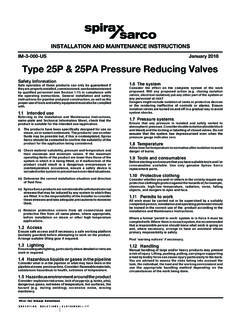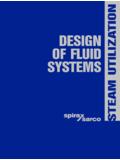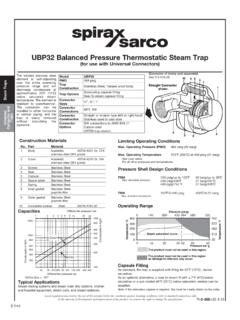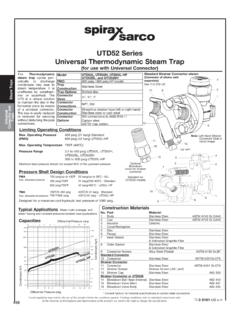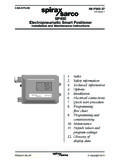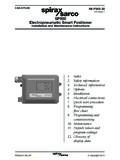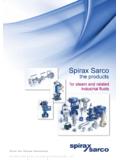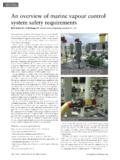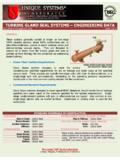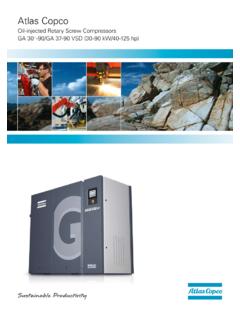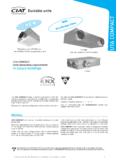Transcription of Condensate recovery in industrial steam systems - Spirax Sarco
1 Condensate recovery in industrial steam systems o n d e n s a t e r e c o v e r Executive Rising pressures of using natural resources The importance of effective Condensate Condensate recovery saves Condensate recovery payback Dealing with Condensate The technology of Condensate steam traps to remove Condensate from the steam Using pumps to return Condensate to the boiler Electrical centrifugal Condensate Mechanical Condensate Automatic pump traps Feedtank heating and Flash steam and its recovery Flash steam vent Closed loop Condensate recovery The Spirax Sarco Condensate recovery portfolioPlease note that all the applications illustrated within this White Paper are diagrammatic representations and are not detailed enough for safe working is a popular and efficient medium for moving heat around a wide variety of processes and premises.
2 In today s cost-conscious environment, it s vital for steam users to make the best possible use of the energy and hot water in steam , so effective Condensate recovery is essential. Condensate is the hot, treated water produced as steam releases its heat energy. It s a valuable resource that contains around 25% of the useful energy in the original steam . It makes sense to return it to the boiler, instead of dumping it to drain. It may be impractical to return all the Condensate to the boiler for various reasons, but in most applications a goal of 75-80% Condensate return is reasonable.
3 Condensate recovery offers several benefits. It saves energy and reduces fuel costs, reduces water charges and chemical treatment costs and brings down effluent charges. This combination leads to a typical payback for new Condensate recovery systems of between one and two years. So it s perhaps unsurprising that most British steam users already have some form of Condensate recovery system in place, although most of them could be improved using the latest techniques and systems . Spirax Sarco offers a full portfolio of the latest Condensate recovery solutions that will help steam users reduce their utility bills and optimise their organisations struggling to find the capital budget to invest in energy-saving measures, rental-style finance arrangements can help them upgrade their Condensate recovery systems sooner rather than later.
4 So they can start to benefit Executive o n d e n s a t e r e c o v e r yDrought or the threat of it across large swathes of the UK appears commonly in the headlines. Low rainfall levels in successive years can quickly deplete water reserves, creating a risk of restrictions and contributing to rising water costs for study by the UK s Environment Agency concludes that: All of the scenarios predicted a future with less water available for people, businesses and the environment. The agency also says that: Future pressures will not be limited to the south and east of England.
5 Under many of the scenarios, the south west and northern England will see significant unmet demand. Running in parallel is the ever-present pressure on energy costs as oil prices fluctuate, yet remain on an upward trend. According to the UK s Department of Energy and Climate Change, gas consumers generally saw prices, excluding the Climate Change Levy (CCL), increase between Q3 2010 and Q3 2011 by an average of 25%.The impact of future green policies is also uncertain. For example, the 21 March 2012 Budget statement by the Chancellor of the Exchequer indicated that the Carbon Reduction Commitment (CRC) could be replaced by an alternative environmental tax, but no details were developments clearly impact steam users because water and energy are the two key resources used to create steam for process and hot water heating.
6 There are a variety of ways that steam -using organisations can reduce their water and energy consumption, ranging from using the latest boiler control technology to ensuring that pipework systems are insulated one of the most effective resource-saving measures for most steam system sites is Condensate recovery installing recovery systems if they are not already present, or enhancing existing systems to improve their Rising pressures of using natural resources Given the pressures on our water resources it is crucial that businesses manage their water use, and adopt new technologies over time to improve their water efficiency and cut and the green economy fact sheet, DEFRA (Department for Environment, Food and Rural Affairs).
7 4 The return of Condensate to the boiler feedtank is commonly recognised as a highly effective way to improve the efficiency of steam plant. Formed by condensed steam , liquid Condensate needs to be drained from pipelines and equipment to avoid the risk of waterhammer. Waterhammer is a risk in a poorly drained steam main, where Condensate collects and forms a slug of water. This water is incompressible - unlike steam - and can cause damage when carried along by the high-speed steam . The importance of effective Condensate 1: Graph showing the heat content of steam and Condensate at the same pressure reveals that Condensate contains around a quarter of the energy of the steam from which it came.
8 Total energy in steamTotal energy in condensatePressure bar gSpecific enthalpy (kJ/kg)5c o n d e n s a t e r e c o v e r yCondensate also contains around one-quarter of the energy of the steam from which it came. Allowing Condensate to pass to drain wastes valuable energy and water, and most steam system sites recognise that Condensate is a valuable resource. There are only a few sites in the UK without any form of Condensate recovery system , but many sites could do more. There are applications in which Condensate is not returned to the boilerhouse for operational reasons either the steam is injected into the end product, for example in animal feed mills or direct steam injection in food processing, or because there is a risk that the Condensate is contaminated and could damage the boiler.
9 Typical examples include chemical processing, dyeing and food processing, where food particles could enter the Condensate recovery system . However, even these systems could potentially recover Condensate by installing contamination detection systems or heat exchange systems to avoid boiler contamination. PanSteamSteamSteamPanProcess vesselsSpace heating systemCondensateCondensateFeedtankMake-u p waterBoilerFeedpumpVatVatFigure 2: Schematic showing the steam and Condensate loop with Condensate being recovered and returned to the boiler Condensate recovery saves money Condensate is a valuable resource and the recovery of even small quantities is often economically justifiable.
10 Reduced fuel costs:Normally, Condensate will contain around 25% of the usable energy of the steam from which it came. Returning this to the boiler feedtank can save thousands of pounds per year in energy alone. Using Condensate to heat the boiler feedwater leaves the boiler with less to do in converting the water to steam . In other words, less fuel is needed to produce steam from hot water rather than cold water. Every 6oC rise in feedwater temperature achieved by using free energy equats approximately to a 1% fuel saving: Condensate is distilled water with little total dissolved solids (TDS).

